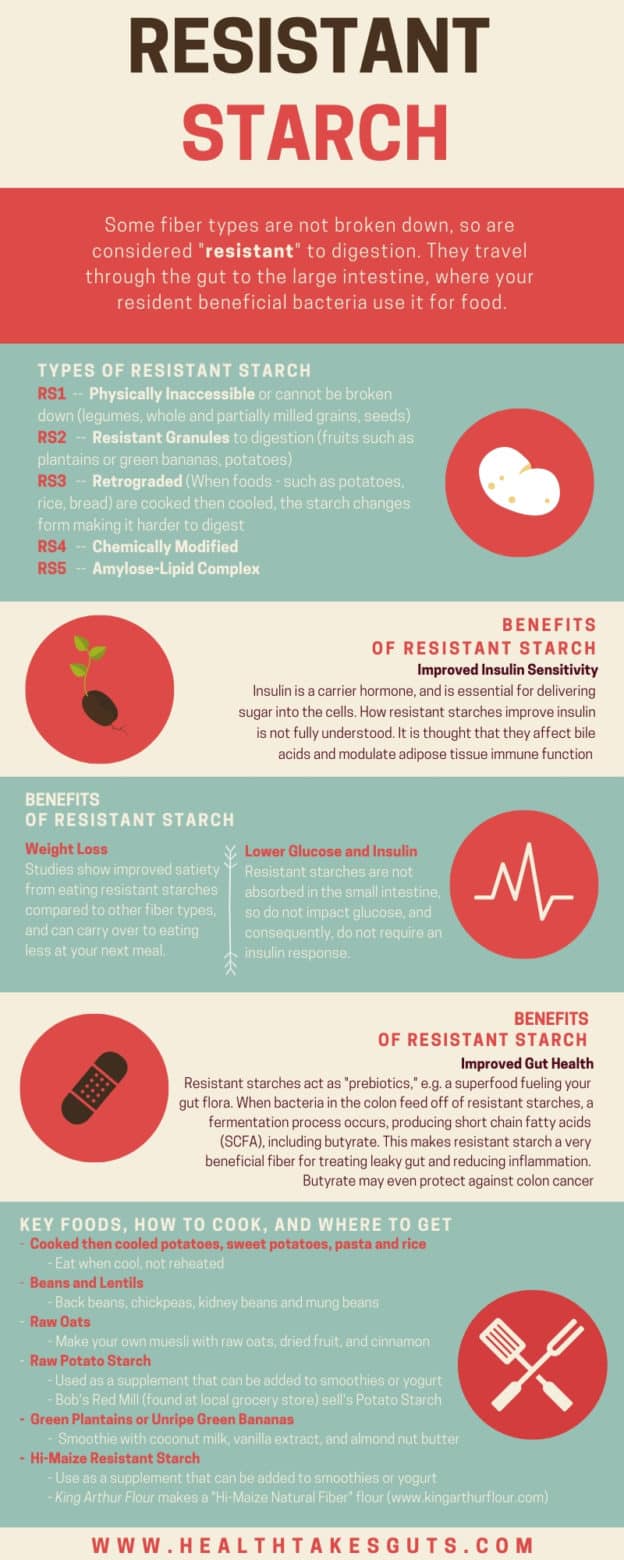Resistant starch is just that: starch that is resistant to digestion. This type of starch isn’t digested, absorbed, or used as fuel by the body. Although digestible and absorbable carbohydrates are an integral part of a strong and balanced diet, resistant starch (RS) provides some additional health benefits most are not aware of! Have no idea what I am talking about? Read on!
Starch is a type of carbohydrate that is digested and turned into glucose for the body to use immediately for energy. Starch is found in foods such as bread, pasta, rice, beans, and potatoes. RS is a type of starch that is “resistant” or unable to be digested by digestive enzymes in your small intestine. As a result, RS passes through the gut into the large intestine where your gut bacteria ferment it. RS is a prebiotic: food for probiotics. The beneficial bacteria in your gut uses prebiotics as fuel. By eating RS, beneficial bacteria can proliferate and colonize in your large intestine leading to countless health benefits.
RS also helps with weight loss as it improves satiety. RS has also been shown to help improve insulin resistance, as it is not digested and does not raise your blood sugar.
So where can you find these incredible starches? There are 5 different sources of RS, based on how these starches are reacting with digestive enzymes in the body:
RS1 — Physically Inaccessible: Cannot be broken down due to thick outer cell walls (legumes, whole and partially milled grains, seeds)
RS2 — Resistant Granules: Resistant to digestion due to starch’s crystalline structure (fruits such as plantains or green bananas, raw potatoes, or high-maize flour)
RS3 — Retrograded Starch: When starchy foods – such as potatoes, or rice- are cooked then cooled, the starch changes from digestible to a resistant form of starch making it harder to digest. These foods have to be eaten cold. If reheated, the starch returns to digestible.
RS4 — Chemically Modified: Where starches are modified to optimize the structural and functional characteristics and nutritional properties
RS5 – Amylose-Lipid Complex: Stearic acid-complexed high-amylose starches.
RS1-RS3 will be the easiest to incorporate into your diet. You may already be doing this and not even knowing it – great! If you are, how much should be consuming? Integration of RS into the diet should be slow as too much may cause bloating or gas, especially if these foods are not commonly found in your diet already. RS needs vary per individual, but most research suggests aiming for an intake of about 20 grams per day to obtain the health benefits.
One such benefit is the production short-chain fatty acids, such a butyrate. Butyrate is not only the primary source of energy for your large intestinal cells, but research supports butyrate is also responsible for regulating cellular homeostasis with actions including: diarrhea control, reducing oxidative stress in the gut, anti-carcinogenic, anti-inflammatory and immune modulation properties. This makes RS a very beneficial fiber for treating leaky gut and reducing inflammation.
Now the important information – how can you incorporate RS into your diet!
- Use Canned chickpeas and make your own hummus for sandwiches or a dip! Find recipe here.
- Add canned beans (black beans, kidney beans, mung beans, etc)
- Add to your leafy green salad
- Make a cold three bean salad
- Add lentils to a soup or salad
- Overnight oats (raw oats soaked in yogurt, milk or non-dairy milk and refrigerated overnight)
- Add in your favorite oatmeal toppings (fruit, nuts, etc). Find different recipes here.
- Cooked then cooled potatoes
- Homemade potato salad
- Puree cooked white potatoes to create a chilled garlic potato soup
- Cooked then cooled rice or pasta
- Try cooking rice, potatoes, beans, and pasta a day in advance and cool in the fridge overnight
- Homemade pasta salad
- Green bananas or Plantains (before they are ripened and yellow)
- Make a smoothie
- Slice and mix with yogurt and oats for breakfast
- Easy Plantain Tortillas (served cold). Find recipe here.
- Raw Potato Starch Flour (used in supplement form) or sprinkled on your food. Do not heat or bake with.
- Add to your yogurt, overnight oats or smoothie
- Mix in with your salad dressing
- BUY à Bob’s Red Mill (purchase here) or find in the baking aisle of your local grocery store
- Hi-Maize Flour (used in supplement form) or sprinkled on your food. Do not heat or bake with.
- Add to your yogurt, overnight oats or smoothie
- BUY à King Arthur Flour makes a Hi-Maize Natural Fiber Flour (purchase here)

